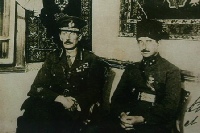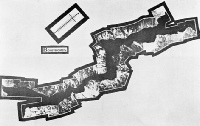General Sir C harles Harington KCB CMG DSO had been sent to Turkey to negotiate with General Ismet the establishment of an Armistice in preparation for the signing of a peace treaty. During these negotiations the Squadron carried out reconnaissance sorties along the neutral zone, and although the aircraft were forbidden to approach nearer than two miles to the neutral boundary the pilots were able to report Turkish activity in the area. This information was sent by WIT to General Harrington’s ship and was of great value to him in his negotiations with General Ismet. (In the accompanying photograph of the mosaic of the Bosphorous taken in November 1922 shows the use
harles Harington KCB CMG DSO had been sent to Turkey to negotiate with General Ismet the establishment of an Armistice in preparation for the signing of a peace treaty. During these negotiations the Squadron carried out reconnaissance sorties along the neutral zone, and although the aircraft were forbidden to approach nearer than two miles to the neutral boundary the pilots were able to report Turkish activity in the area. This information was sent by WIT to General Harrington’s ship and was of great value to him in his negotiations with General Ismet. (In the accompanying photograph of the mosaic of the Bosphorous taken in November 1922 shows the use s of aerial photography at the time). A story is told that, during these discussions, General Ismet jokingly said to General Harington that the latter seemed to know more about the disposition of Turkish Troops than he did himself which was of course true!
s of aerial photography at the time). A story is told that, during these discussions, General Ismet jokingly said to General Harington that the latter seemed to know more about the disposition of Turkish Troops than he did himself which was of course true!
The experiments with radio-
For a time, war between Britain and Turkey seemed possible, but Canada refused to agree as did France and Italy. British public opinion did not want a war. The British military did not either, and General Harrington refused to relay an ultimatum to the Turks because he counted on a negotiated settlement. The Conservatives in Britain's coalition government refused to follow Liberal Prime Minister David Lloyd George, who with Winston Churchill was calling for war.
The crisis quickly ended when Turkey, having overwhelmed the Greeks, agreed to a negotiated settlement that gave it the territory it wanted. Flying at San Stefano came to an end after peace was ratified in Lausanne on 23rd August 1923. The following day orders were received to evacuate Turkey.
On the evacuation of all British troops from Turkey General Sir Charles Harrington KCB CMG DSO Commander in Chief, praised the way in which the RAF had co-



The Chanak Crisis -






